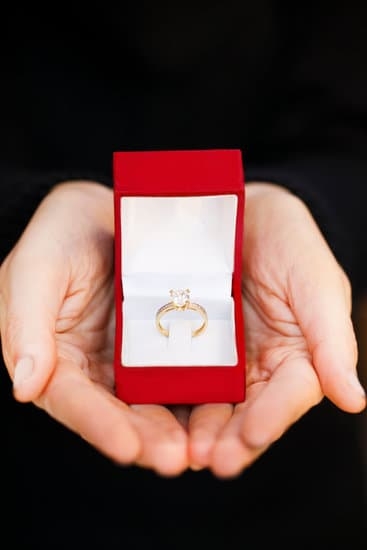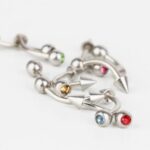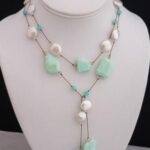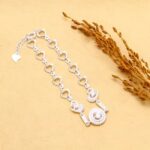Properly storing fine jewelry is essential for its longevity and preservation. Fine jewelry, whether it’s heirloom pieces, luxury items, or sentimental gifts, is often a significant investment and should be cared for accordingly. In this article, we will explore the different types of fine jewelry, factors to consider when choosing storage options, the best materials for storage, organizing tips, cleaning and maintenance advice, review of various storage options, and best practices for preventing damage and tarnishing.
Fine jewelry includes pieces made from precious metals like gold and silver, adorned with gemstones such as diamonds, emeralds, sapphires, and rubies. Whether it’s a diamond engagement ring or a vintage pearl necklace, each type of fine jewelry requires special attention when it comes to storage. By understanding the importance of proper storage methods for different types of fine jewelry and learning how to care for them effectively, you can ensure that your collection remains beautiful and timeless.
When it comes to storing fine jewelry, there are several factors to consider such as the type of metal used in the piece (gold vs. silver), whether the jewelry contains gemstones (diamonds vs. pearls), and how frequently you wear certain pieces. All these factors play an important role in determining the best way to store your fine jewelry collection.
In this article, we will delve into these considerations to help you make informed decisions on how to store your valuable pieces while keeping them safe from damage or tarnishing.
Understanding the Different Types of Fine Jewelry
When it comes to understanding the different types of fine jewelry, it’s important to know that there are various materials and styles that fall under this category. Fine jewelry typically includes items made from precious metals such as gold, silver, and platinum, as well as gemstones like diamonds, emeralds, and rubies. Here are the different types of fine jewelry:
- Rings: This type of fine jewelry is often worn on the fingers and can include engagement rings, wedding bands, and fashion rings.
- Necklaces: Necklaces are typically worn around the neck and can feature pendants, chains, or intricate designs with gemstones.
- Earrings: Earrings come in various styles such as studs, hoops, dangles, or chandelier earrings. They can be adorned with diamonds or other precious stones.
- Bracelets: Bracelets are worn around the wrist and can be bangles, cuffs, chain bracelets or charm bracelets.
When considering how to store these different types of fine jewelry properly, it’s essential to take into account their individual characteristics and how they might be affected by environmental factors such as light exposure or moisture.
Another thing to consider is the value of the jewelry piece. For instance, if you have inherited a valuable diamond ring from your grandmother or invested in a high-quality opal necklace – proper storage is crucial to maintain their condition over time. This leads us to ask: what is the best way to store fine jewelry?
Factors to Consider When Choosing Storage Options for Fine Jewelry
When it comes to choosing the best storage options for fine jewelry, there are several factors to consider in order to ensure the longevity and preservation of your precious pieces. Here are some essential factors to keep in mind:
- Material: Consider the material of the storage option, as certain metals or materials can react with the jewelry and cause tarnishing or discoloration.
- Type of Jewelry: Different types of jewelry may require different storage solutions. For example, delicate necklaces may need a different type of storage than chunky bracelets or statement rings.
- Accessibility: Accessibility is an important factor to consider when choosing storage options for fine jewelry. You’ll want a system that allows you to easily access your pieces while keeping them organized and protected.
Each of these factors is crucial in determining the best way to store fine jewelry. By considering these elements, you can select the most appropriate storage options that will keep your collection safe and well-preserved.
In addition to these factors, it’s also important to consider the size and scale of your fine jewelry collection. Whether you have a small, curated selection or an extensive array of pieces, there are storage options available to accommodate collections of any size. What works best for one person’s collection may not be suitable for another, so it’s essential to take inventory of your pieces and assess your specific needs before choosing a storage solution.
The Best Materials for Storing Fine Jewelry
When it comes to storing fine jewelry, choosing the right materials is crucial in ensuring that your precious pieces remain in pristine condition. The best materials for storing fine jewelry are those that provide adequate protection against tarnishing, scratching, and damage from environmental factors. Here are some of the top materials to consider when it comes to storing your fine jewelry collection.
Soft Fabric
Soft fabrics such as velvet, silk, or suede are excellent choices for lining jewelry boxes or pouches. These materials help prevent scratches and abrasions on delicate metals and gemstones. Additionally, they provide a soft cushioning effect that adds an extra layer of protection for your fine jewelry pieces.
Anti-Tarnish Cloth
Anti-tarnish cloth is specially designed to protect jewelry from tarnishing caused by exposure to air and moisture. This type of fabric is treated with chemicals that absorb and neutralize the compounds responsible for tarnishing, helping to keep your jewelry looking its best for longer periods.
Acid-Free Paper
For long-term storage of fine jewelry, using acid-free paper is essential to prevent any chemical reactions that may occur between the metals and gemstones with acidic materials. This type of paper is also suitable for wrapping individual pieces before placing them in storage containers or compartments.
By utilizing these materials for storing your fine jewelry, you can minimize the risk of damage and deterioration over time, ultimately preserving the beauty and value of your collection. Consider incorporating these materials into your storage options to ensure the longevity of your precious jewelry pieces.
Overall, understanding the importance of selecting the right material for storing your fine.
Organizing Your Fine Jewelry Collection
When it comes to organizing your fine jewelry collection, there are several tips and tricks to consider in order to keep your precious pieces safe and well-maintained. Whether you have a small or large collection, proper organization is essential for easy access, preventing damage, and preserving the longevity of your jewelry.
Use Jewelry Trays and Dividers
One of the best ways to store and organize your fine jewelry collection is by using jewelry trays and dividers. These can help keep your pieces separate from each other, preventing tangling, scratching, and other forms of damage. Look for trays with compartments or adjustable dividers to easily customize the storage space to accommodate different types of jewelry.
Consider a Jewelry Armoire
For those with a larger collection, investing in a jewelry armoire can be an excellent storage solution. These armoires typically come with various compartments, drawers, hooks, and built-in organizers specifically designed for different types of jewelry. They not only provide ample storage space but also offer an elegant way to display and access your collection.
Implement a Labeling System
To make it easier to find specific pieces within your collection, consider implementing a labeling system. Whether you use small tags attached to each piece or simply label the compartments or drawers where they are stored, this can save time and effort when searching for a particular item. Additionally, it helps maintain the organization of your fine jewelry collection over time.
By following these tips and tricks for organizing your fine jewelry collection, you can ensure that your precious pieces are kept safe, easily accessible, and well-maintained. Proper organization not only prevents damage and tarnishing but also allows you to enjoy and appreciate your jewelry collection for years to come.
The Importance of Properly Cleaning and Maintaining Fine Jewelry
Properly cleaning and maintaining fine jewelry is crucial to preserving its beauty and longevity. Fine jewelry, whether it’s made of precious metals, gemstones, or pearls, can easily accumulate dirt, oils, and other residues from everyday wear. Without regular maintenance, these residues can cause the jewelry to appear dull and lose its sparkle over time. Additionally, neglecting to clean fine jewelry can lead to damage and tarnishing, reducing its value and aesthetic appeal.
To ensure the longevity of your fine jewelry collection, it is essential to understand the proper cleaning methods for different types of jewelry. For example, while some pieces may be safe to clean with a gentle soap and water solution at home, others may require professional cleaning by a jeweler to avoid causing damage.
It’s important to research and follow the specific care instructions recommended for each type of fine jewelry to prevent any unintended harm during the cleaning process.
In addition to regular cleaning, proper maintenance also involves inspecting your fine jewelry for any signs of wear or damage. Loose stones, weakened clasps, or damaged settings should be addressed promptly by a professional jeweler to prevent further problems.
By staying proactive in caring for your fine jewelry collection through regular cleaning and maintenance, you can ensure that each piece maintains its beauty and value for years to come. Understanding these key aspects of caring for fine jewelry will ultimately help in preserving its quality and appearance.
Review of Different Storage Options for Fine Jewelry
When it comes to storing fine jewelry, there are various options to consider that can help preserve its beauty and value. One of the most common storage options for fine jewelry is a jewelry box.
These boxes often have compartments and slots for different types of jewelry, helping to keep them organized while also preventing them from getting tangled or scratched. Another popular option is jewelry bags, which are soft and often lined with velvet or silk to protect the jewelry from scratches and tarnishing.
For those with a larger collection of fine jewelry, a jewelry case may be the best storage option. Jewelry cases often come with multiple layers and compartments, offering ample space to store various types of jewelry such as rings, necklaces, bracelets, and earrings. Additionally, there are specially designed trays available for specific types of jewelry like rings or earrings that can be used within a larger case.
In recent years, some people have also turned to specialized anti-tarnish storage solutions such as tarnish-resistant bags or cloth pouches. These options are ideal for preventing tarnishing on silver pieces and can provide an extra layer of protection when storing fine jewelry.
Ultimately, the best way to store fine jewelry will depend on several factors including the type of pieces in your collection, the available storage space you have at your disposal, how frequently you wear your jewelry, and your budget.
| Jewelry Storage Option | Key Features |
|---|---|
| Jewelry Box | Compartmentalized with slots for organization; prevents tangling and scratching. |
| Jewelry Bag | Lined with soft materials like velvet or silk; protects against scratches and tarnishing. |
| Jewelry Case | Multiple layers and compartments; ideal for large collections; specifically designed trays for different types of jewelry. |
| Tarnish-Resistant Storage Solutions | Bags or cloth pouches specially designed to prevent tarnishing on silver pieces. |
Best Practices for Storing Fine Jewelry to Prevent Damage and Tarnishing
When it comes to storing fine jewelry, proper care and attention are essential to prevent damage and tarnishing. The way you store your precious pieces can have a significant impact on their longevity and preservation. In this section, we will explore the best practices for storing fine jewelry to ensure that your collection remains in pristine condition.
One of the most important factors to consider when storing fine jewelry is the type of material used for storage. It is recommended to use soft, non-abrasive materials such as velvet or silk to prevent scratches and damage to the metal or gemstones. Additionally, keeping each piece separate from one another can help prevent tangling and scratching.
Proper organization is key when it comes to storing fine jewelry. Whether you opt for jewelry boxes, bags, cases, or other storage options, it is important to keep similar pieces together and separate different types of jewelry from each other. This not only makes it easier to find specific items but also reduces the risk of damage from pieces rubbing against each other.
Lastly, it’s crucial to consider the storage environment. Fine jewelry should be kept away from extreme temperatures, moisture, and sunlight as these can cause damage over time. Storing your pieces in a cool, dry place away from direct sunlight is highly recommended.
| Best Practices | Details |
|---|---|
| Material | Use soft materials such as velvet or silk to prevent scratches |
| Organization | Keep similar pieces together; separate different types of jewelry from each other |
| Storage Environment | Away from extreme temperatures, moisture, and sunlight |
Conclusion
In conclusion, properly storing your fine jewelry is crucial for its longevity and preservation. The numerous types of fine jewelry, such as diamonds, gemstones, and precious metals, require different storage options to ensure they remain in their original condition. Factors to consider when choosing storage options include the material of the jewelry, frequency of use, and space available for storage.
When it comes to the best materials for storing fine jewelry, it is important to opt for non-abrasive and non-reactive materials such as velvet-lined boxes or tarnish-resistant pouches. Organizing your fine jewelry collection is also essential to prevent tangling, scratching, or damage. Properly cleaning and maintaining your fine jewelry is equally important in preserving its shine and luster.
In reviewing different storage options for fine jewelry, it becomes clear that there are a variety of choices including boxes, bags, cases, and more. However, the best practices for storing fine jewelry ultimately revolve around preventing damage and tarnishing.
Ultimately, by following these tips and tricks for proper storage and maintenance mentioned in this article will help ensure that your fine jewelry remains beautiful for years to come. Remember: proper storage is essential in preserving the value and beauty of your precious possessions.
Frequently Asked Questions
What Is the Best Storage for Fine Jewelry?
The best storage for fine jewelry is in a jewelry box specifically designed for that purpose. These boxes often have individual compartments and soft lining to protect delicate pieces from scratches and damage. They also usually have a secure closure to prevent loss or theft.
How Do You Store Fine Jewellery?
Fine jewelry should be stored in a cool, dry place away from sunlight and excessive heat. Ideally, each piece should be stored separately to prevent scratching or tangling. Using anti-tarnish pouches or cloths can also help preserve the shine of precious metals.
Is It OK to Store Jewelry in Plastic Containers?
It is not recommended to store jewelry in plastic containers, especially if it is fine or valuable jewelry. Plastic can cause metals to tarnish more quickly and may not provide adequate protection against scratches and other damage. It’s better to invest in proper jewelry storage solutions like fabric-lined boxes or soft pouches.

Welcome to my jewelry blog! My name is Sarah and I am the owner of this blog.
I love making jewelry and sharing my creations with others.
So whether you’re someone who loves wearing jewelry yourself or simply enjoys learning about it, be sure to check out my blog for insightful posts on everything related to this exciting topic!





